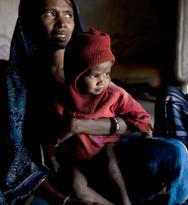More Women & Children Than Ever Starving in Midst of Indian Wealth
Excerpts from an article by India-based Globe & Mail correspondent Stephanie Nolan:
 A staggering 40 per cent of undernourished children in the world are Indian; the rate here is twice as high as it is in all of Sub-Saharan Africa and five times higher than in China.
A staggering 40 per cent of undernourished children in the world are Indian; the rate here is twice as high as it is in all of Sub-Saharan Africa and five times higher than in China.
The land of the economic boom finishes third-last on Unicef's global list of child nourishment, worse than either Sudan or Ethiopia. In fact, the number of starving children is increasing 2.5 per cent annually, while population growth is barely 1.4 per cent.
Breastfeeding – a free, critical intervention that can make a massive difference in survival past the first month of life – is a fraught part of the nutrition puzzle here.
Ms. Adivasi says that she waited until three days after Devsingh was born to nurse her son. For the first two days, which Unicef calls the most critical for determining infant health, she gave him nothing, believing her colostrum (the antibody-rich, yellow liquid new mother's bodies produce before milk) was unhealthy.
Overhearing her recount this, a couple of village men jump into the discussion: “Even an animal would not feed its child with its first milk!” one man says. Another adds, “No woman here would be allowed to give that to a baby.”
India's central government has helpfully put up billboards at the entrance to many of these villages, extolling the virtue of colostrum in lines of Hindi script that, of course, almost no one here can read.
Photo by Zackary Canepari/For The Globe and Mail
Click here to read the full story
By Stephanie Nolan
Globe & Mail, Canada
Related AWR links:
Napalese Women Confined by Tradition
 A staggering 40 per cent of undernourished children in the world are Indian; the rate here is twice as high as it is in all of Sub-Saharan Africa and five times higher than in China.
A staggering 40 per cent of undernourished children in the world are Indian; the rate here is twice as high as it is in all of Sub-Saharan Africa and five times higher than in China.The land of the economic boom finishes third-last on Unicef's global list of child nourishment, worse than either Sudan or Ethiopia. In fact, the number of starving children is increasing 2.5 per cent annually, while population growth is barely 1.4 per cent.
Breastfeeding – a free, critical intervention that can make a massive difference in survival past the first month of life – is a fraught part of the nutrition puzzle here.
Ms. Adivasi says that she waited until three days after Devsingh was born to nurse her son. For the first two days, which Unicef calls the most critical for determining infant health, she gave him nothing, believing her colostrum (the antibody-rich, yellow liquid new mother's bodies produce before milk) was unhealthy.
Overhearing her recount this, a couple of village men jump into the discussion: “Even an animal would not feed its child with its first milk!” one man says. Another adds, “No woman here would be allowed to give that to a baby.”
India's central government has helpfully put up billboards at the entrance to many of these villages, extolling the virtue of colostrum in lines of Hindi script that, of course, almost no one here can read.
Photo by Zackary Canepari/For The Globe and Mail
Click here to read the full story
By Stephanie Nolan
Globe & Mail, Canada
Related AWR links:
Napalese Women Confined by Tradition